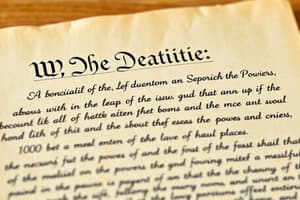Podcast
Questions and Answers
संविधान क्या स्थापित करने के लिए बनाया गया था?
संविधान क्या स्थापित करने के लिए बनाया गया था?
- संयुक्त राष्ट्र के लिए संशोधित (correct)
- संघर्ष के लिए सुरक्षा प्रदान करने के लिए
- भारत सरकार की नीतियों को बदलने के लिए
- संघर्ष के लिए संरक्षा प्रदान करने के लिए
संविधान में कौन-कौन से महत्वपूर्ण हक और जिम्मेदारियाँ दर्शाई गई है?
संविधान में कौन-कौन से महत्वपूर्ण हक और जिम्मेदारियाँ दर्शाई गई है?
- केवल प्रशासनिक हक
- केवल न्यायिक हक
- तीनों, सरकारी, प्रशासनिक और न्यायिक हक (correct)
- केवल सरकारी हक
संविधान में सत्ता के प्रति सम्पूर्ण नियंत्रण कैसे प्राप्त किया जाता है?
संविधान में सत्ता के प्रति सम्पूर्ण नियंत्रण कैसे प्राप्त किया जाता है?
- तीनों, संसद, कानूनी प्रक्रिया और न्यायिक
- केवल संसद
- प्रणाली (correct)
- केवल कानूनी प्रक्रिया
किस प्रमुख शाखा का मुख्याध्यक्ष संविधान की व्याख्या करता है?
किस प्रमुख शाखा का मुख्याध्यक्ष संविधान की व्याख्या करता है?
संविधान का संशोधन कितनी बार हुआ है?
संविधान का संशोधन कितनी बार हुआ है?
संविधान द्वारा स्थापित सरकारी व्यवस्था को क्या कहा जाता है?
संविधान द्वारा स्थापित सरकारी व्यवस्था को क्या कहा जाता है?
संविधान की पहली दस संशोधन किसे संरक्षित करते हैं?
संविधान की पहली दस संशोधन किसे संरक्षित करते हैं?
संविधान किसके लिए विशेष शक्तियाँ प्रदान करता है?
संविधान किसके लिए विशेष शक्तियाँ प्रदान करता है?
संविधान के कौन-कौन से महत्वपूर्ण पहलु हैं?
संविधान के कौन-कौन से महत्वपूर्ण पहलु हैं?
संविधान किसे संरक्षित करता है?
संविधान किसे संरक्षित करता है?
Flashcards are hidden until you start studying
Study Notes
Constitution
The Constitution is the supreme law of the United States, established by the Founding Fathers to create a framework for the government of the United States. It outlines the fundamental rights and responsibilities of the three branches of the government and the states, and provides the basis for all laws and legal processes. The Constitution has been amended many times to reflect changes in the country's needs and values, and it continues to serve as the cornerstone of American democracy.
Separation of Powers
The Constitution establishes the separation of powers, which divides the government's functions into three branches: the legislative, executive, and judicial branches. This system ensures that no single branch has complete control over the government, preventing the concentration of power and potential tyranny.
- Legislative Branch: This branch, composed of the House of Representatives and the Senate, enacts laws, declares war, and determines federal tax policy.
- Executive Branch: This branch, headed by the President, enforces the laws and foreign policy, and has the power to veto legislation from Congress.
- Judicial Branch: This branch, led by the Supreme Court, interprets the Constitution and federal law and serves as the final arbiter of disputes between the branches.
Amendments
The Constitution has been amended 27 times to address issues such as slavery, women's suffrage, and the rights of criminals. The process for proposing and ratifying constitutional amendments is outlined in Article V of the Constitution.
Bill of Rights
The first ten amendments to the Constitution, known as the Bill of Rights, protect the rights of individual citizens, including freedom of speech, religion, and the press, and the right to bear arms. These amendments form the basis of American civil liberties and limit the power of the government to interfere with individual rights.
Checks and Balances
The Constitution's system of checks and balances allows each branch of government to limit the power of the others. For example, the President can veto legislation from Congress, but Congress can override the veto with a two-thirds vote in both the House and the Senate. Similarly, the judiciary can declare laws unconstitutional, but the other branches can challenge those decisions through the process of constitutional amendment.
Federalism
Federalism is the system of government established by the Constitution, in which powers are divided between the federal government and the states. This system allows states to retain control over their own affairs while also allowing the federal government to manage national issues. The Constitution grants specific powers to the federal government, while the states retain all remaining powers.
In conclusion, the United States Constitution is a complex and enduring document that has shaped the country's political system and guaranteed the rights of its citizens. Its separation of powers, amendment process, Bill of Rights, checks and balances, and federalism have contributed to the stability and success of American democracy.
Studying That Suits You
Use AI to generate personalized quizzes and flashcards to suit your learning preferences.




